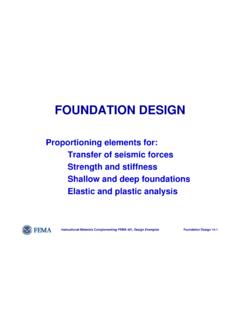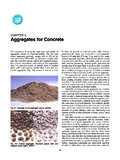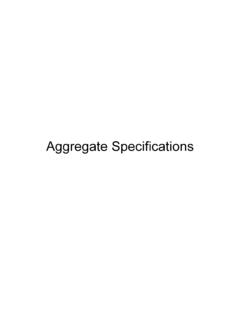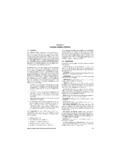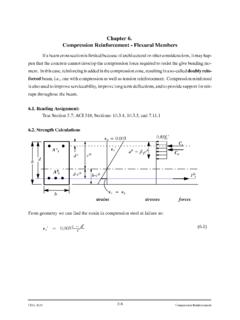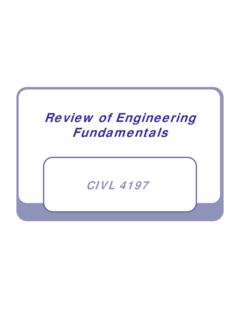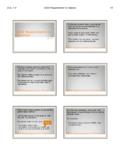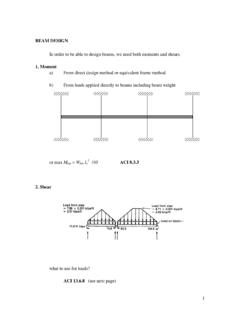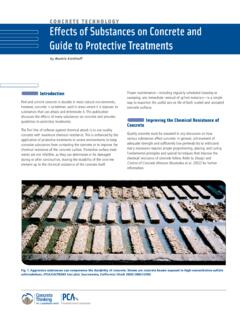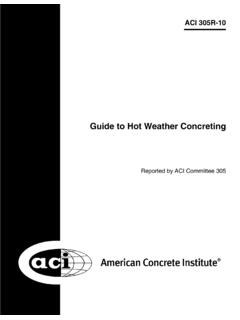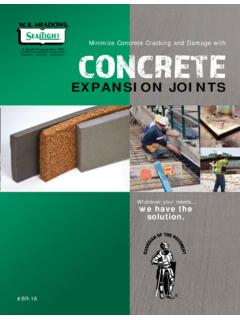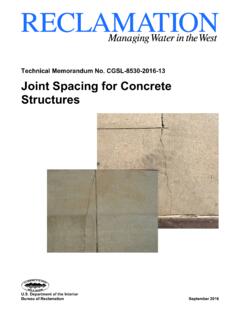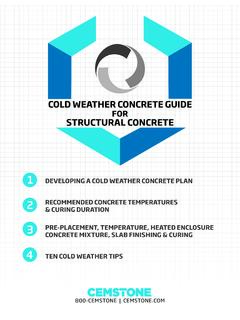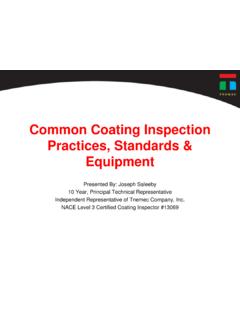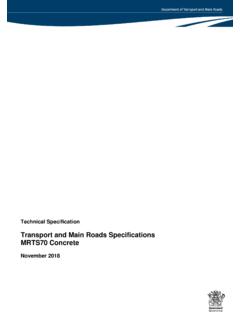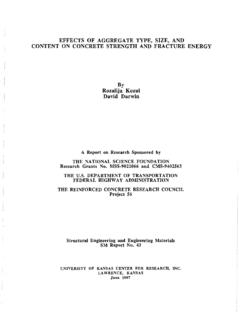Transcription of Curing Concrete, Chapter 12 - Memphis
1 Curing is the maintenance of a satisfactory moisture con-tent and temperature in concrete for a period of time imme-diately following placing and finishing so that the desiredproperties may develop (Fig. 12-1). The need for adequatecuring of concrete cannot be overemphasized. Curing has astrong influence on the properties of hardened concrete ;proper Curing will increase durability, strength, watertight-ness, abrasion resistance, volume stability, and resistance tofreezing and thawing and deicers. Exposed slab surfacesare especially sensitive to Curing as strength developmentand freeze-thaw resistance of the top surface of a slab canbe reduced significantly when Curing is portland cement is mixed with water, a chemicalreaction called hydration takes place. The extent to whichthis reaction is completed influences the strength and dura-bility of the concrete . Freshly mixed concrete normally con-tains more water than is required for hydration of the ce-ment; however, excessive loss of water by evaporation candelay or prevent adequate hydration.
2 The surface is partic-ularly susceptible to insufficient hydration because it driesfirst. If temperatures are favorable, hydration is relativelyrapid the first few days after concrete is placed; however, itis important for water to be retained in the concrete duringthis period, that is, for evaporation to be prevented or sub-stantially proper Curing , concrete becomes stronger, moreimpermeable, and more resistant to stress, abrasion, andfreezing and thawing. The improvement is rapid at earlyages but continues more slowly thereafter for an indefiniteperiod. Fig. 12-2 shows the strength gain of concrete withage for different moist Curing periods and Fig. 12-3 showsthe relative strength gain of concrete cured at 12 Curing ConcreteFig. 12-1. Curing should begin as soon as the concretestiffens enough to prevent marring or erosion of the sur-face. Burlap sprayed with water is an effective method formoist Curing .
3 (69973)60504030201000 7 289036586420 Age at test, daysMoist-cured entire timeIn air after 28 days moist curingIn air after 7 days moist curingIn laboratory air entire timeCompressive strength, MPaCompressive strength, 1000 psiFig. 12-2. Effect of moist Curing time on strength gain ofconcrete (Gonnerman and Shuman 1928). 219 HOMEPAGEThe most effective method for Curing concretedepends on the materials used, method of construction,and the intended use of the hardened concrete . For mostjobs, Curing generally involves applying Curing com-pounds, or covering the freshly placed and finished con-crete with impermeable sheets or wet burlap. In somecases, such as in hot and cold weather, special care usingother precautions is mixtures with high cement contents and lowwater-cement ratios (less than ) may require specialcuring needs. As cement hydrates (chemically combiningwith water) the internal relative humidity decreases caus-ing the paste to self-desiccate (dry out) if no external wateris provided.
4 The paste can self-desiccate to a level wherehydration stops. This may influence desired concreteproperties, especially if the internal relative humiditydrops below 80% within the first seven days. In view of220 Design and Control of concrete Mixtures EB001this, membrane-forming Curing compounds may notretain enough water in the concrete . Therefore, foggingand wet Curing become necessary to maximize hydration(Copeland and Bragg 1955). Fogging during and afterplacing and finishing also helps minimize plastic crackingin concretes with very low water-cement ratios (especiallyaround or less).When moist Curing is interrupted, the development ofstrength continues for a short period and then stops afterthe concrete s internal relative humidity drops to about80%. However, if moist Curing is resumed, strength devel-opment will be reactivated, but the original potentialstrength may not be achieved.
5 Although it can be done ina laboratory, it is difficult to resaturate concrete in thefield. Thus, it is best to moist-cure the concrete continu-ously from the time it is placed and finished until it hasgained sufficient strength, impermeability, and of water will also cause the concrete to shrink,thus creating tensile stresses within the concrete . If thesestresses develop before the concrete has attained adequatetensile strength, surface cracking can result. All exposedsurfaces, including exposed edges and joints, must be pro-tected against moisture proceeds at a much slower rate when theconcrete temperature is low. Temperatures below 10 C(50 F) are unfavorable for the development of earlystrength; below 4 C (40 F) the development of earlystrength is greatly retarded; and at or below freezingtemperatures, down to -10 C (14 F), little or no recent years, a maturity concept has been introducedto evaluate the development of strength when there is vari-ation in the Curing temperature of the concrete .
6 Maturity isthe product of the age of the concrete and its average curingtemperature above a certain base temperature. Refer toChapter 14 for more information on the maturity concept. Itfollows that concrete should be protected so that its tem-perature remains favorable for hydration and moisture isnot lost during the early hardening METHODS AND MATERIALSC oncrete can be kept moist (and in some cases at a favor-able temperature) by three Curing methods:1. Methods that maintain the presence of mixing waterin the concrete during the early hardening include ponding or immersion, spraying orfogging, and saturated wet coverings. These methodsafford some cooling through evaporation, which isbeneficial in hot Methods that reduce the loss of mixing water fromthe surface of the concrete . This can be done by cov-ering the concrete with impervious paper or plasticsheets, or by applying membrane-forming temperature, C ( F)125105856545250204060 Age, daysCompressive strength, % 28-day strength23/23 (73/73)32/32 (90/90)10/10 (50/50)23/10 (73/50)Casting/ Curing temperature, C ( F)12010080600204060 Age, daysCompressive strength, % 23 C (73 F)23/23 (73/73)32/32 (90/90)10/10 (50/50)23/10 (73/50)Fig.
7 12-3. Effect of Curing temperature on strength gain(top) relative to 28-day strength and (bottom) relative to thestrength of concrete at 23 C (73 F) (Burg 1996).221 Chapter 12 Curing Concrete3. Methods that accelerate strength gain by supplyingheat and additional moisture to the concrete . This isusually accomplished with live steam, heating coils,or electrically heated forms or method or combination of methods chosendepends on factors such as availability of Curing materials,size, shape, and age of concrete , production facilities (inplace or in a plant), esthetic appearance, and a result, Curing often involves a series of proceduresused at a particular time as the concrete ages. For example,fog spraying or plastic covered wet burlap can precedeapplication of a Curing compound. The timing of eachprocedure depends on the degree of hardening of the con-crete needed to prevent the particular procedure fromdamaging the concrete surface (ACI 308 1997).
8 Ponding and ImmersionOn flat surfaces , such as pavements and floors, concretecan be cured by ponding. Earth or sand dikes around theperimeter of the concrete surface can retain a pond ofwater. Ponding is an ideal method for preventing loss ofmoisture from the concrete ; it is also effective for main-taining a uniform temperature in the concrete . The curingwater should not be more than about 11 C (20 F) coolerthan the concrete to prevent thermal stresses that couldresult in cracking . Since ponding requires considerablelabor and supervision, the method is generally used onlyfor small most thorough method of Curing with water con-sists of total immersion of the finished concrete method is commonly used in the laboratory forcuring concrete test specimens. Where appearance of theconcrete is important, the water used for Curing by pond-ing or immersion must be free of substances that will stainor discolor the concrete .
9 The material used for dikes mayalso discolor the and SprinklingFogging (Fig. 12-4) and sprinkling with water are excellentmethods of Curing when the ambient temperature is wellabove freezing and the humidity is low. A fine fog mist isfrequently applied through a system of nozzles orsprayers to raise the relative humidity of the air over flat-work, thus slowing evaporation from the surface. Foggingis applied to minimize plastic shrinkage cracking until fin-ishing operations are complete. Once the concrete has setsufficiently to prevent water erosion, ordinary lawn sprin-klers are effective if good coverage is provided and waterrunoff is of no concern. Soaker hoses are useful on surfacesthat are vertical or nearly cost of sprinkling may be a disadvantage. Themethod requires an ample water supply and carefulsupervision. If sprinkling is done at intervals, the concretemust be prevented from drying between applications ofwater by using burlap or similar materials; otherwisealternate cycles of wetting and drying can cause surfacecrazing or CoveringsFabric coverings saturated with water, such as burlap,cotton mats, rugs, or other moisture-retaining fabrics, arecommonly used for Curing (Fig.)
10 12-5). Treated burlaps thatreflect light and are resistant to rot and fire are requirements for burlap are described in the Specifica-tion for Burlap Cloths Made from Jute or Kenaf(AASHTO M182), and those for white burlap-polyethylene sheeting aredescribed in ASTM C 171 (AASHTO M 171).Fig. 12-4. Fogging minimizes moisture loss during and afterplacing and finishing of concrete . (69974)Fig. 12-5. Lawn sprinklers saturating burlap with water keepthe concrete continuously moist. Intermittent sprinkling isacceptable if no drying of the concrete surface occurs.(50177) Curing -paper patches. When the condition of the paper isquestionable, additional use can be obtained by using it indouble addition to Curing , impervious paper providessome protection to the concrete against damage from sub-sequent construction activity as well as protection fromthe direct sun. It should be light in color and nonstainingto the concrete .
